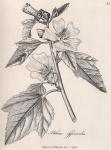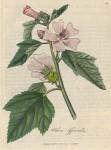053. Althaea officinalis. Marsh-mallow.

 Also see 054. Malva sylvestris. Common mallow.
Also see 054. Malva sylvestris. Common mallow.
Synonyma. Althaea. Pharm. Lond. & Edinb.
Althaea Dioscoridis et Plinii. Bauh. Pin. p. 315.
Althaea vulgaris. Park. Theat. p. 303. Raii. Hist. 602. Synop. 252.
Althaea Ibiscus. Gerard. Emac. p. 933.
Althaea sive Bismalva. J. Bauh. Hist. vol. ii, p. 954.
Althaea tomentosa herbacea, cause erecto, foliis cordato-lanceolatis obsolete trifidis. Hal. Stirp. Helv. n. 1047.
Althaea officinalis. Flor. Dan. tab. 530. Withering. Bot. Arrang. p. 735.
(greek) s. (greek) Dioscorid.
Class Monadelphia. Ord. Polyandria. Lin. Gen. Plant. 839.
Ess. Gen. Ch. Cal. duplex; exterior 9-fidus. Arilli plurimi, monospermi.
Spec. Char. A. foliis simplicibus tomentosis.
The root is perennial, long, tough, white, and fibrous: the stalk is upright, firm, woolly, somewhat branched towards the top, and rises to the height of three or four feet: the leaves are ovalish, or heart-shaped, commonly with a lobe on each side, pointed, irregularly serrated, covered with a soft down, and stand upon long round footstalks: the stipulae are two, narrow, and placed at the base of each leaf-stalk: the flowers are large, and consist of five petals, inversely heart-shaped, indented at the apex, and of a pale purple colour: the calyx is double, the exterior consisting of nine and the interior of five narrow pointed segments: the stamina are numerous, united at the base, and terminated by kidney-shaped anthers: the germen is orbicular: the styli cylindrical, and furnished with many long bristly stigmata: the seeds are kidney-shaped, numerous, placed in a circle, and covered with an arillus. It is a native of England, and grows commonly near the sea shore, or about salt marshes, and flowers in August.
The Althaea seems to have been known to the ancients, [It is called Althaea, says Dioscorides (greek) a multiplici excellentique quam in methodo praestat utilitate. l. 3. c. 163. p. 236. Hence also vismalva & bismalva, malvaviscus, malva-ibiscus, (Alston Lecl. on the Mat. Med.) and therefore may be supposed to be the hibiscus of Virgil:— Hoedorumque gregem viridi compellere hibisco. Ec. ii. 1. 30. et Ec. x. 1. 71.] and has continued in very general officinal use by practitioners in every country where the science of medicine is regularly cultivated. "The dry roots of this plant, boiled in water, give out half their weight of a gummy matter, [This is thought to be nearly allied to Gum arabic, Tragacanth, Starch, &c. and it has been found to dissolve myrrh, and some other resinous substances, more readily than the first. Buchholz Act. Nat. Cur. Tom. p. 60. Expt. 32.] which, on evaporating the aqueous fluid, forms a flavourless yellowish mucilage. The leaves afford scarcely one-fourth of their weight, and the flowers and seeds still less." [Lewis Mat. Med. p. 40.] This gluten or mucilaginous matter with which the Althaea abounds, is the medicinal part of the plant, and is commonly employed for its emollient and demulcent qualities. Its use is recommended where the natural mucus of membranes becomes acrid or abraded; "for obtunding and incrassating acrimonious thin fluids, in tickling coughs from defluctions on the fauces and lungs, in hoarseness, erosions of the stomach and interlines, stranguary, [We may here remark however, that in the opinion of Dr. Cullen these "demulcents can have no effect as such in the mass of blood, or in passing by the various excretions." Mat. Med. vol. ii. p. 411.] and for lubricating and relaxing the passages in nephritic and calculous complaints." [Lewis l. c.] Radix Althaeae formerly had a place in many of the compounds in the pharmacopoeias, but now it is only directed in the form of a syrup.

